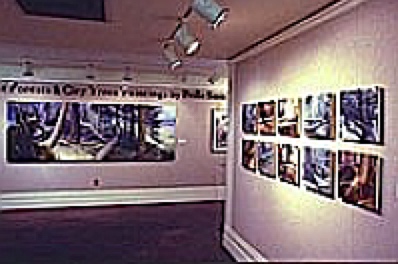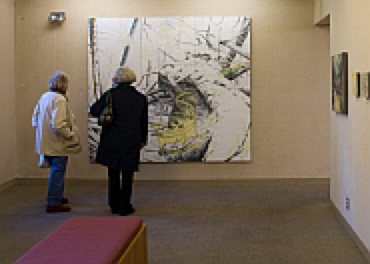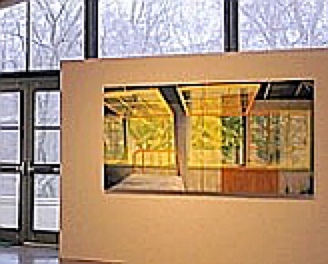Biography
Prilla Smith Brackett is known for working with landscape conceptually, depicting more than a
description of a place. Her new body of work explores ideas of enclosure, ambiguity, refuge and the
human body, using spaces from Cappadocia's ancient underground cities and architectural motifs
from its early churches, carved inside the rocky mounds that dot the landscape.
Brackett has exhibited throughout eastern US including a solo show traveling to 8 venues in
New England and the mid Atlantic States. Other venues include DeCordova Sculpture Park and
Museum, MA, National Academy of Sciences, DC, DanforthArt, MA, and Hanoi Contemporary Art
Center, Vietnam.
Her honors include a finalist award in painting from the Massachusetts Cultural Council,
residencies at the Virginia Center for the Creative Arts and the Ragdale Foundation, an award &
residency at the Ucross Foundation, an Earthwatch Artist award in Madagascar, and a fellowship in
painting at the Bunting Institute of Radcliffe College. Born in New Orleans, Brackett has social science
degrees from Sarah Lawrence College and the University of California/Berkeley. She earned her MFA
in drawing & painting from the University of Nebraska/Lincoln. She added printmaking to her practice
in 2003. Brackett lives and works in Boston, MA.
Statement 1: Refuge
This work looks at ideas of enclosure, ambiguity, refuge and the human body, using spaces from
Cappadocia's ancient underground cities and architectural motifs from its early churches, carved
inside the rocky mounds that dot the landscape.
Many peoples traversed and invaded Turkey’s central Anatolia, and I am fascinated by what they
left behind. Groups including the Hittites and the earliest Christians carved secret underground cities
in which they and their animals could live for up to three months to survive attack. The soft volcanic
tufa hardened after being carved out leaving organic, strangely shaped spaces and orifaces. While the
church fragments probably originated in later centuries than the underground cities, they represent
another aspect of the culture of Anatolian peoples, another reality from a different era. While
archeologists might know the function of many of these spaces and orifices, to me they remain
mysterious and appealing.
As in my earlier work, these new images continue to be informed by layering, transparency, the
evocation of memory, a conceptual use of landscape, and the juxtaposition of the natural with the
human-made. I like the translucency of Duralar, and work on both sides, with acrylic inks and Acryla
gouache.
Initially I wanted to obscure the the cave-like spaces so they would be difficult to read and to
integrate pattern from the churches, isolated from the architecture on which it was found. More
recently I have been experimenting with allowing the spaces to be visible, even those rendered in flat
color. In some pieces the spaces are dominant and spatial. Their shapes reference the body,
suggesting the subconscious. Integrating patterned fragments of architecture suggests the role of
the spiritual, the intellectual, and references the memory of lost peoples.
Statement 2: Dreams of Home
My approach to landscape is conceptual; I use landscape to convey more than a description of a
place. I explore the intermingling of the domestic man-made with the natural, in monoprints, mixed
media paintings on panel, and drawings: forest images & semi-transparent old furniture from a house
my mother’s family lived in for 90 years. Everyone from my great grandmother, widow of a young
painter who died in 1882, down to my children contributed to the rich ambiance of that house.
Placing furniture from previous eras in forests I have known creates a narrative uncertainty I find
fascinating.
In both monoprints and paintings I play with the furniture's transparency and its location in the
forest: floating above, embedded within, or buried below. Over time the furniture has become less
substantial and less grounded. The prints in my two recent monoprint suites have a quiet quality in
which the furniture sometimes disappears into an etherial forest.
Over time I have alternated doing monoprints and paintings. The monoprints have greatly
influenced the paintings. In the latter I have layered transparent colors with the (often surprising)
color results found in my monoprints, "printed" with paint, and used paint applied linearly, influenced
by small drypoint marks. Similarly, the distilled quality of a group of mostly black and white drawings
led to large, mixed media works on panel using drawing materials and limited thin acrylic and oil
paint. These works remain open in feel and explore how scale contributes to meaning.
Old growth forests show the whole life cycle of trees. Trees struck by lightning or fallen trees
with their branches making wild gestures show nature's violence. The domestic in such settings
seems jarring, although our traditions see forests as places of make-believe, of solace & spirituality, of
refuge & hidden secrets. But in the dreams of old furniture made of forest wood might there also be
dark scenes of family discord? How do these disparate domestic & natural elements resolve shared
conflict to arrive at peace at last?


